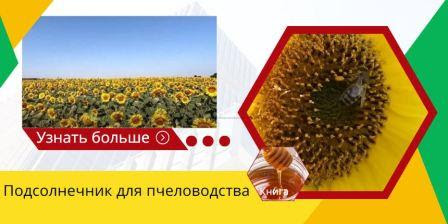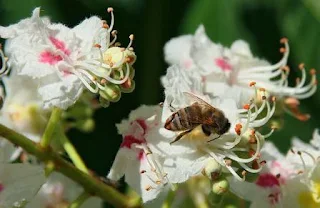Chestnut horse honey plant
The streets and parks of many settlements in Europe are decorated with horse chestnuts. The horse chestnut tree is not only beautiful during the entire growing season, but also the horse chestnut honey plant, from which bees collect nectar and pollen in spring. Therefore, horse chestnut as a honey plant is important for urban beekeeping. How chestnuts bloom, what are the features of a chestnut and much more, you can find out in this article. Read to the end, it will be interesting.
Content
- Description of honey plant horse chestnut
- Horse chestnut as a honey plant
- When does horse chestnut bloom?
- How many days does horse chestnut bloom?
- Chestnut horse honey plant or not?
- What is the honey productivity of horse chestnut?
- Horse chestnut honey?
- What else is useful horse chestnut for bees?
- How far does horse chestnut go north?
- Ornamental chestnut horse honey plant or not?
- Horse chestnut in folk medicine
- Reproduction of horse chestnut as a honey plant
Description of honey plant horse chestnut
The honey plant is horse chestnut, the Latin name is Aesculus hippocastanum L. Horse chestnut should not be confused with edible chestnut, which can often be found in the Caucasus or the Mediterranean.
Edible chestnut or sowing chestnut as a honey plant, as well as chestnut honey from it, are discussed in a separate article. Therefore, now we will consider horse chestnut as a honey plant.
Horse chestnut is a tree that can reach a height of up to 30 meters, the chestnut tree has a wide dense crown.
The bark of the chestnut trunk is dark maroon, cracking, the old branches are brownish gray, the young shoots are yellowish brown, glabrous.
The chestnut leaves are opposite, petiolate, rounded, up to 25 cm in diameter. They are palmately complex and consist of 5-7 sessile leaflets. The leaves of horse chestnut are wedge-shaped, obovate, pointed at the apex, unevenly bifurcate, the leaves of the chestnut are dark green on top, wrinkled, the leaves are lighter below, pubescent along the veins with red hairs.
Horse chestnut flowers collected in erect, large panicles, cone-shaped, which reach a length of 20 cm. The corolla of the flower is white with a yellowish, and later with a reddish spot.
The horse chestnut fruit is a green round box dotted with thorns, which reaches a diameter of 6 cm.
Horse chestnut as a honey plant
When does horse chestnut bloom? As a rule, horse chestnut honey plant blooms in late May May - early June. Due to weather conditions and terrain, the flowering time of horse chestnut may be shifted. During this period, chestnut trees are most decorative, because the chestnut flowers form candles that are densely arranged throughout the tree, which gives the chestnut tree a unique look.
How long does horse chestnut bloom or how many days does horse chestnut bloom? The flowering period of horse chestnut lasts 10-15 days.
Chestnut horse honey plant or not? This is a fairly common question that can be answered with yes horse chestnut honey plant. Bees are very willing to visit horse chestnut flowers to collect nectar and pollen. It is interesting to note that if there is a lot of nectar in the chestnut flowers, then the flowers have a yellow spot, but as the chestnut flower is visited by bees and collect nectar, the spot on the flower becomes more and more red, and the bees stop visiting flowers with a red spot, realizing that the nectar is no longer there.
What is the honey productivity of horse chestnut? The honey productivity of horse chestnut cannot be considered very high. One flower releases 1.7 mg of sugar in the nectar. The honey productivity of horse chestnut is at the level of 25 kg per hectare. In urban conditions, if there is a lot of horse chestnut in a settlement, bees can bring up to 2 kg of honey per day. However, the melliferous plant horse chestnut, as a rule, does not form large arrays, but is used specifically to decorate streets, parks, alleys, and in urban beekeeping, it is a rather important honey plant and pollen plant. Since the bees actively collect nectar and pollen from the horse chestnut, spending them on feeding the brood and preparing the family for the main honey collection from white acacia or linden and other honey plants.
Tell us about the horse chestnut honey? The nectar that the bees collect from the horse chestnut, they process into chestnut honey, which is transparent and almost colorless in the liquid state, the honey crystallizes easily, so it is never left to the bees for the winter. However, in most countries, the absence of large arrays of horse chestnut does not give beekeepers a commodity bribe and the bees completely spend it on their needs.
On the territory of the Balkans, including Bulgaria, horse chestnut can be found in mountain forests, where it grows together with ash, alder and maple, climbing mountains to a height of 1000 - 1200 m. In such forests, you can find chestnut trees that reach the age of 200 - 300 years. Such chestnut trees reach a height of up to 30 meters, and a trunk diameter of up to 2 m. One middle-aged tree can produce 72 g of honey and 5 g of pollen.
What else is horse chestnut good for bees? Scientists also point out that horse chestnut is also important for beekeeping because bees from its buds collect a sticky substance - propolis, which is extremely important for bees to control pathogens in the nest.
How far does horse chestnut go north? Also, it should be noted that to the north the horse chestnut reaches the latitude of St. Petersburg. Having grown stronger, horse chestnut blooms annually at the latitude of Moscow. But in more severe conditions it can grow, but not bloom or bloom in some years. As a rule, in more severe climates, it is planted protecting from cold winds.
Ornamental chestnut horse honey plant or not? Horse chestnut is often used for landscaping settlements, so a large number of decorative chestnut forms have been developed, such as a narrow pyramidal chestnut, weeping, umbrella-shaped and many others. Only the decorative form of horse chestnut with double flowers is not a honey plant, all other decorative forms of horse chestnut are honey plants.
Horse chestnut in folk medicine
Horse chestnut preparations are used for the prevention and treatment of postoperative thrombosis, post-traumatic edema, inflammation and thromboembolism. Alcoholic extract of horse chestnut fruits lowers blood pressure, stimulates cardiac activity, dilates blood vessels. With thrombophlebitis, chestnut fruit extract reduces the overall inflammatory response and local edema.
Reproduction of horse chestnut as a honey plant
Considering that horse chestnut is undemanding to soils, durable, it makes sense to grow chestnut as a supporting honey plant in settlements, including it in parks or intra-quarter plantings.
Horse chestnut is best propagated by seedlings, but can be grown from seeds.




Комментариев нет:
Отправить комментарий